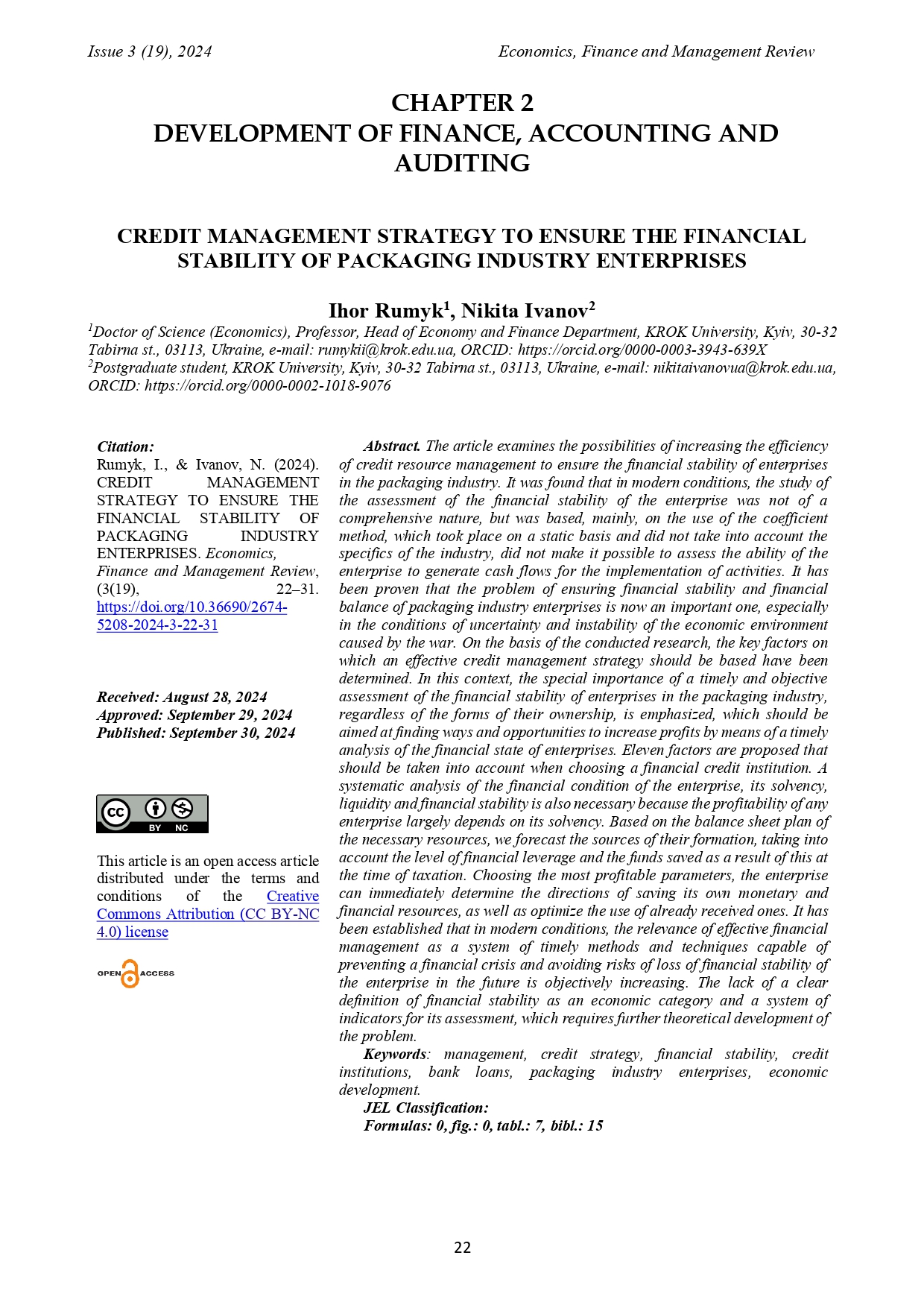CREDIT MANAGEMENT STRATEGY TO ENSURE THE FINANCIAL STABILITY OF PACKAGING INDUSTRY ENTERPRISES
DOI:
https://doi.org/10.36690/2674-5208-2024-3-22-31Keywords:
management, credit strategy, financial stability, credit institutions, bank loans, packaging industry enterprises, economic developmentAbstract
The article examines the possibilities of increasing the efficiency of credit resource management to ensure the financial stability of enterprises in the packaging industry. It was found that in modern conditions, the study of the assessment of the financial stability of the enterprise was not of a comprehensive nature, but was based, mainly, on the use of the coefficient method, which took place on a static basis and did not take into account the specifics of the industry, did not make it possible to assess the ability of the enterprise to generate cash flows for the implementation of activities. It has been proven that the problem of ensuring financial stability and financial balance of packaging industry enterprises is now an important one, especially in the conditions of uncertainty and instability of the economic environment caused by the war. On the basis of the conducted research, the key factors on which an effective credit management strategy should be based have been determined. In this context, the special importance of a timely and objective assessment of the financial stability of enterprises in the packaging industry, regardless of the forms of their ownership, is emphasized, which should be aimed at finding ways and opportunities to increase profits by means of a timely analysis of the financial state of enterprises. Eleven factors are proposed that should be taken into account when choosing a financial credit institution. A systematic analysis of the financial condition of the enterprise, its solvency, liquidity and financial stability is also necessary because the profitability of any enterprise largely depends on its solvency. Based on the balance sheet plan of the necessary resources, we forecast the sources of their formation, taking into account the level of financial leverage and the funds saved as a result of this at the time of taxation. Choosing the most profitable parameters, the enterprise can immediately determine the directions of saving its own monetary and financial resources, as well as optimize the use of already received ones. It has been established that in modern conditions, the relevance of effective financial management as a system of timely methods and techniques capable of preventing a financial crisis and avoiding risks of loss of financial stability of the enterprise in the future is objectively increasing. The lack of a clear definition of financial stability as an economic category and a system of indicators for its assessment, which requires further theoretical development of the problem.
Downloads
References
Abdalqhadr, A. (2020). The role of corporate governance in economic development. Economics, Finance and Management Review, 3, 129-142. DOI: https://doi.org/10.36690/2674-5208-2020-3-129
AUB (2024). Aub analytics. Retrieved from: https://aub.org.ua/index.php/en/aub-analytics/aub-powerbi-en
Burkova, L., Shepeliuk, V., & Rtyshchev, S. (2023). Management of financial risks of enterprises as a prevention component of their financial instability and bankruptcy for the sustainable development achieving. Economics, Finance and Management Review, 1, 98-114. DOI: https://doi.org/10.36690/2674-5208-2023-1-98
But, T.V., & Netudyhata, K.L. (2020). Analysis of the financial sustainability of enterprises in modern conditions”. Efektyvna ekonomika, 3, DOI: 10.32702/2307-2105-2020.3.156
Cernavskis, K. (2012). Financial stability of enterprise as the main precondition for sustainable development of economy. Regional Formation and Development Studies, 3(8). Retrieved from: https://core.ac.uk/download/pdf/233177068.pdf
Damane, M., & Ho, S.Yu (2024). The Impact of financial Inclusion on financial Stability: review of Theories and international Evidence. Development studies research, 11(1), DOI: https://doi.org/10.1080/21665095.2024.2373459
Gadanecz, B., & Jayaram, K. (2008). Measures of Financial Stability - A Review, Irving Fisher Committee Bulletin, 31(1), 365-383. Retrieved from: https://www.bis.org/ifc/publ/ifcb31ab.pdf
Jeanneau, S. (2014). Financial Stability Objectives and Arrangements – What’s New?, BIS Paper. Retrieved from: https://www.bis.org/publ/bppdf/bispap76e_rh.pdf
Melikhova, T., & Melikhov, Y. (2023). Information support for financial analysis of industrial enterprises and the influence of the size of shop expenses on tax planning at the micro level to improve management efficiency. Economics, Finance and Management Review, 4, 71-79. DOI: https://doi.org/10.36690/2674-5208-2023-4-71-79
Rumyk, I., & Pylypenko, O. (2021). Management of financial and economic activities of integrated enterprises on an innovative basis. Science Notes of KROK University, 2(62), 166-175. DOI: https://doi.org/10.31732/2663-2209-2021-62-166-175 [in Ukrainian]
Rumyk, I., & Pylypenko, O. (2022). Financial support of enterprises: possibilities of using cognitive modeling. Science Notes of KROK University, 2(66), 44-52. DOI: https://doi.org/10.31732/2663-2209-2022-66-44-52 [in Ukrainian]
Salamah, S.N. (2023). Financial Management Strategies to Improve Business Performance. Journal of Contemporary Administration and Management (ADMAN), 1(1), 9-12. DOI: https://doi.org/10.61100/adman.v1i1.3
Schinasi, G. (2004). Defining Financial Stability. International Monetary Fund, 187. Retrieved from: https://www.imf.org/external/pubs/ft/wp/2004/wp04187.pdf
Vovchenko, N.G., Holina, M.G., Orobinskiy, A.S., & Sichev R.A. (2017). Ensuring Financial Stability of Companies on the Basis of International Experience in Construction of Risks Maps, Internal Control and Audit. European Research Studies, 20(1), 350-368. Retrieved from: https://www.ersj.eu/repec/ers/papers/17_1_p33.pdf
Petrukha N., Petrukha S., Alekseienko N., Kushneruk O., Mazur A. Social Imperatives of Public Finance: War Adaptation and Principles of Post-War Recovery. Financial and Credit Activity-Problems of Theory and Practice. 2023. Volume 3 (50). P. 358–371. DOI: https://doi.org/10.55643/fcaptp.3.50.2023.4031 URL: https://fkd.net.ua/index.php/fkd/article/view/4031

Downloads
Published
How to Cite
Issue
Section
License

This work is licensed under a Creative Commons Attribution-NonCommercial 4.0 International License.








